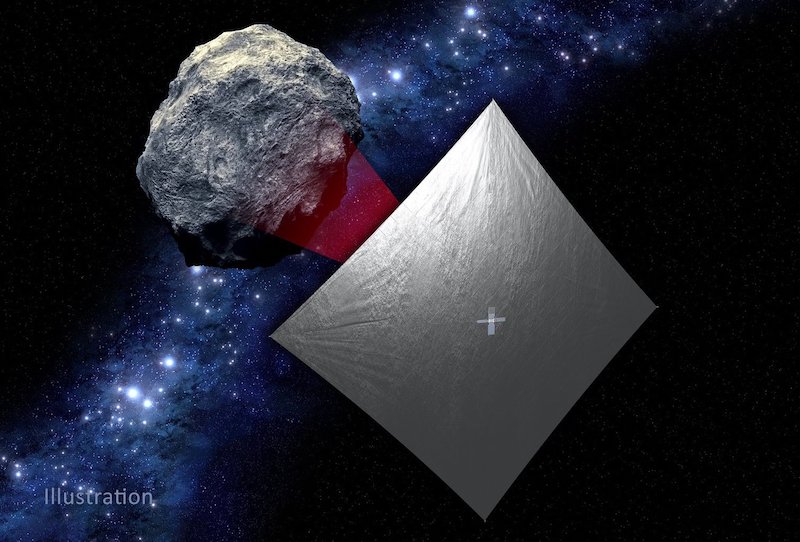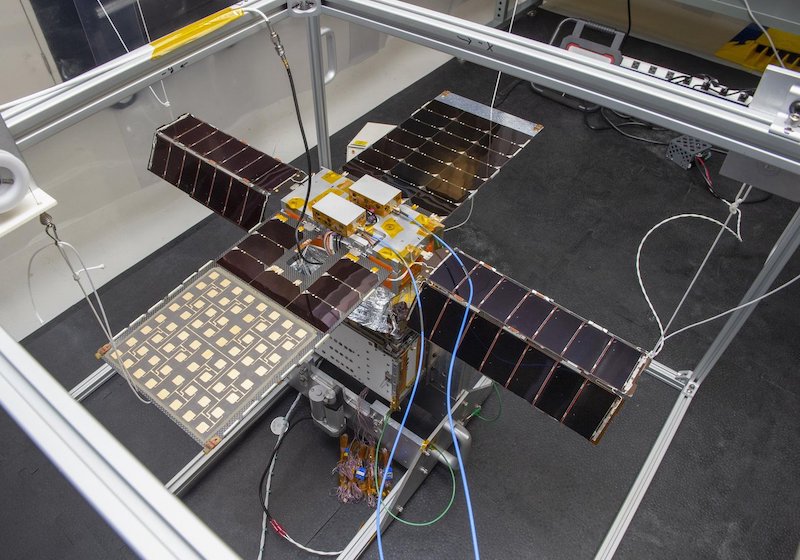
NEA Scout readies for launch
Space fans still hope NASA’s long-awaited Artemis program will get off the ground before the end of this year. The ultimate mission is a human return to the moon. But that’s not the only quest of the Artemis program, which will also enable several secondary payloads to hitch a ride to space. One of these is NASA’s Near-Earth Asteroid Scout – or NEA Scout – due to launch with the uncrewed test flight Artemis 1 no earlier than November 26, 2021. NEA Scout is a shoebox-sized cubesat that will navigate space and visit a near-Earth asteroid, all while sailing on sunlight. NEA Scout’s voyage will take approximately two years. But, by its end, it’ll provide researchers with an arsenal of data on near-Earth asteroids and how solar sail propulsion works in outer space.
Les Johnson, the mission’s principal investigator at NASA’s Marshall Space Flight Center, said:
NEA Scout will be America’s first interplanetary mission using solar sail propulsion. There have been several sail tests in Earth orbit, and we are now ready to show we can use this new type of spacecraft propulsion to go new places and perform important science.
Sailing on sunlight with NEA Scout
The cubesat is equipped with stainless steel alloy booms that will deploy its solar sail when prompted. That sail is plastic, coated in an aluminum film, thinner than a human hair, and about the size of a racquetball court. All solar sails generate thrust using the same solar-powered physics. Photons – energized particles of sunlight – reflect and bounce off the sail, which creates a constant push. It’s a slow and diminutive process but can accelerate the spacecraft to high speeds over time. Johnson added:
This type of propulsion is especially useful for small, lightweight spacecraft that cannot carry large amounts of conventional rocket propellant.
Once at the asteroid, NEA Scout will employ a science-grade camera to record images at less than 4 inches (10 cm) per pixel. The low-velocity flyby makes such high-resolution imaging possible here, with the spacecraft moving at less than 100 feet per second (30 meters per second).
Julie Castillo-Rogez, the mission’s principal investigator at NASA’s Jet Propulsion Laboratory, said:
The images gathered by NEA Scout will provide critical information on the asteroid’s physical properties such as orbit, shape, volume, rotation, the dust and debris field surrounding it, plus its surface properties.

Why visit small asteroids?
Scientists plan to use these images to study the asteroid. NASA presumes that the data obtained will help scientists understand a smaller class of asteroids – less than 330 feet (100 m) across – that spacecraft have not explored. They will use this data to determine what is required to reduce risk, increase effectiveness, and improve robotic and human space exploration design and operations, added Castillo-Rogez.
While these rocky neighbors may be small, they are important. Detections of near-Earth asteroids have steadily risen in the past decade and are expected to continue growing. Not only do they offer opportunities as exploration destinations and in situ resource use; they provide essential data for planetary defense.
Jim Stott, the NEA Scout technology project manager, said:
Despite their size, some of these small asteroids could pose a threat to Earth. Understanding their properties could help us develop strategies for reducing the potential damage caused in the event of an impact.
In a statement dated July 13, 2021, NASA wrote that NEA Scout is currently stowed inside its Space Launch System (SLS) at the Kennedy Space Center on the coast of Florida. It’s been packaged into a dispenser and attached to the adapter connecting SLS with its companion capsule, Orion.

Artemis: A return to the moon
In case you haven’t been following it closely, the Artemis program is a truly exciting new program, which will return humans to the surface of the moon. To date, only 12 humans have walked on the moon, half a century ago. For Artemis, the U.S. government will work with industry and international partners to send a man and the first woman to the moon. At a press briefing on February 4, 2021, White House press secretary Jen Psaki (@PressSec on Twitter) said:
I’m very excited about it now to tell my daughter all about it … Lunar exploration has broad and bicameral support in Congress, most recently detailed in the FY2021 omnibus spending bill. And certainly we support this effort and endeavor.
That statement was a big relief to those who wondered how the Artemis program might fare under the new Joe Biden administration.
February 4 press briefing on YouTube here
February 4 press briefing official transcript here
Bottom line: NASA’s Near-Earth Asteroid Scout, a cubesat launching on Artemis 1, will navigate space and visit a near-Earth asteroid by sailing on sunlight. Once at the asteroid, it will employ a science-grade camera to record images at less than 4 inches (10 cm) per pixel.
Read more from EarthSky: NASA’s moon program – Artemis – boosted at White House press briefing











